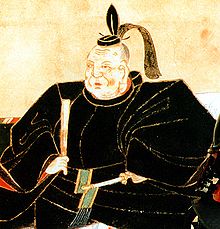| Tokugawa Ieyasu | |
| Born: | January 31, 1543 |
|---|---|
| Place of Birth: | Okazaki Castle, Mikawa province |
| Died: | June 1, 1616 |
| Cause of Death: | Cancer or Syphilis |
| Place of Death: | Sumpu province |
| Style name: | 徳川 家康 |
| Served: | Imagawa Tokugawa |
| Participation(s): | Battle of Anegawa Battle of Mikatagahara Battle of Nagashino Battle of Komaki-Nagakute Battle of Sekigahara Battle of Osaka Castle |
Tokugawa Ieyasu (徳川 家康), was the first Shogun of the Tokugawa shogunate, which was the start of a relatively peaceful period in Japan's history that lasted for the next 250 years. [1]
Biography[]
Born Matsudaira Takechiyo of the Matsudaira clan, Ieyasu grew up in a chaotic period. He was sent at four years old as a hostage to cement a Matsudaira alliance with the neighboring Imagawa clan in 1547, but was captured en route by their common enemy, the Oda clan. Held until his father's death in 1549, Ieyasu returned home briefly before going back to the Imagawa as a hostage. Their defeat by Oda Nobunaga in 1560 at the Battle of Okehazama freed Ieyasu to regain leadership of the Matsudaira, and he immediately allied with Nobunaga, changing his name to Tokugawa Ieyasu and seizing Imagawa land.
In 1570 he moved to the former Imagawa territory and for the next 12 years expanded his lands and influence through Nobunaga's campaigns, despite being forced to kill his first wife and order his son's suicide in 1579 as proof of his loyalty to Nobunaga. Ieyasu seized more land on Nobunaga's death in 1582, becoming master of five provinces by 1583. After inconclusive fighting in 1584, Ieyasu allied with Nobunaga's successor Toyotomi Hideyoshi and married his sister. Following victory at Odawara Castle in 1590, which secured control of eastern Japan, Hideyoshi moved Ieyasu to new lands in the east to undercut his independence. Ieyasu began building an imposing new headquarters at a small fishing port called Edo, later Tokyo.
Occupied in the east while Hideyoshi pursued his futile invasions of Korea, Ieyasu consolidated his new base and, shortly before Hideyoshi's death in 1598, swore with the other great generals to serve Hideyoshi's successor, his infant son Toyotomi Hideyori. Promptly breaking this oath, he began allying with other leaders and in 1600, aided by treachery, crushed his principal opponents at the Battle of Sekigahara, normally taken as marking the beginning of the Edo period. In 1603 he assumed the historic title of shogun, confirming his pre-eminence. In 1605 he passed the title to his son, Tokugawa Hidetada but retained paramount authority, organizing two attacks on Osaka Castle in 1614 and 1615 which finally defeated Hideyori and the remaining Toyotomi forces, thus completing the reunification of Japan under one government.
He organized new laws to regulate the court and the military clans, and laid the foundations for over 250 years of peace under Tokugawa rule during the Edo period. After his death he was enshrined at Nikko as Tosho Daigongen, an aspect of the Buddha.[2]
Items[]
Mounts[]
White stone: One of Ieyasu Tokugawa's favorite mounts. Despite it's name, it sported a black coat. It is said that this is the horse Ieyasu rode at Sekigahara.[3]
Armor[]
Golden Snake: Armor widely covered by gold leaf. During the Battle at Okehazama, this armor was worn by Ieyasu Tokugawa, when he delivered supplies to Odaki castle in Owari.[4]
